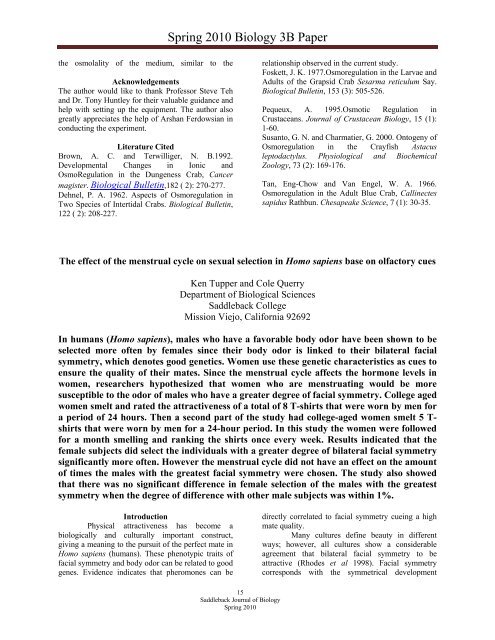Saddleback Journal of Biology - Saddleback College
Saddleback Journal of Biology - Saddleback College
Saddleback Journal of Biology - Saddleback College
Create successful ePaper yourself
Turn your PDF publications into a flip-book with our unique Google optimized e-Paper software.
Spring 2010 <strong>Biology</strong> 3B Paper<br />
the osmolality <strong>of</strong> the medium, similar to the<br />
Acknowledgements<br />
The author would like to thank Pr<strong>of</strong>essor Steve Teh<br />
and Dr. Tony Huntley for their valuable guidance and<br />
help with setting up the equipment. The author also<br />
greatly appreciates the help <strong>of</strong> Arshan Ferdowsian in<br />
conducting the experiment.<br />
Literature Cited<br />
Brown, A. C. and Terwilliger, N. B.1992.<br />
Developmental Changes in Ionic and<br />
OsmoRegulation in the Dungeness Crab, Cancer<br />
magister. Biological Bulletin,182 ( 2): 270-277.<br />
Dehnel, P. A. 1962. Aspects <strong>of</strong> Osmoregulation in<br />
Two Species <strong>of</strong> Intertidal Crabs. Biological Bulletin,<br />
122 ( 2): 208-227.<br />
relationship observed in the current study.<br />
Foskett, J. K. 1977.Osmoregulation in the Larvae and<br />
Adults <strong>of</strong> the Grapsid Crab Sesarma reticulum Say.<br />
Biological Bulletin, 153 (3): 505-526.<br />
Pequeux, A. 1995.Osmotic Regulation in<br />
Crustaceans. <strong>Journal</strong> <strong>of</strong> Crustacean <strong>Biology</strong>, 15 (1):<br />
1-60.<br />
Susanto, G. N. and Charmatier, G. 2000. Ontogeny <strong>of</strong><br />
Osmoregulation in the Crayfish Astacus<br />
leptodactylus. Physiological and Biochemical<br />
Zoology, 73 (2): 169-176.<br />
Tan, Eng-Chow and Van Engel, W. A. 1966.<br />
Osmoregulation in the Adult Blue Crab, Callinectes<br />
sapidus Rathbun. Chesapeake Science, 7 (1): 30-35.<br />
The effect <strong>of</strong> the menstrual cycle on sexual selection in Homo sapiens base on olfactory cues<br />
Ken Tupper and Cole Querry<br />
Department <strong>of</strong> Biological Sciences<br />
<strong>Saddleback</strong> <strong>College</strong><br />
Mission Viejo, California 92692<br />
In humans (Homo sapiens), males who have a favorable body odor have been shown to be<br />
selected more <strong>of</strong>ten by females since their body odor is linked to their bilateral facial<br />
symmetry, which denotes good genetics. Women use these genetic characteristics as cues to<br />
ensure the quality <strong>of</strong> their mates. Since the menstrual cycle affects the hormone levels in<br />
women, researchers hypothesized that women who are menstruating would be more<br />
susceptible to the odor <strong>of</strong> males who have a greater degree <strong>of</strong> facial symmetry. <strong>College</strong> aged<br />
women smelt and rated the attractiveness <strong>of</strong> a total <strong>of</strong> 8 T-shirts that were worn by men for<br />
a period <strong>of</strong> 24 hours. Then a second part <strong>of</strong> the study had college-aged women smelt 5 T-<br />
shirts that were worn by men for a 24-hour period. In this study the women were followed<br />
for a month smelling and ranking the shirts once every week. Results indicated that the<br />
female subjects did select the individuals with a greater degree <strong>of</strong> bilateral facial symmetry<br />
significantly more <strong>of</strong>ten. However the menstrual cycle did not have an effect on the amount<br />
<strong>of</strong> times the males with the greatest facial symmetry were chosen. The study also showed<br />
that there was no significant difference in female selection <strong>of</strong> the males with the greatest<br />
symmetry when the degree <strong>of</strong> difference with other male subjects was within 1%.<br />
Introduction<br />
Physical attractiveness has become a<br />
biologically and culturally important construct,<br />
giving a meaning to the pursuit <strong>of</strong> the perfect mate in<br />
Homo sapiens (humans). These phenotypic traits <strong>of</strong><br />
facial symmetry and body odor can be related to good<br />
genes. Evidence indicates that pheromones can be<br />
directly correlated to facial symmetry cueing a high<br />
mate quality.<br />
Many cultures define beauty in different<br />
ways; however, all cultures show a considerable<br />
agreement that bilateral facial symmetry to be<br />
attractive (Rhodes et al 1998). Facial symmetry<br />
corresponds with the symmetrical development<br />
15<br />
<strong>Saddleback</strong> <strong>Journal</strong> <strong>of</strong> <strong>Biology</strong><br />
Spring 2010

















